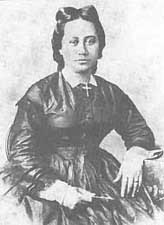- E ho`i ke aloha i Ni`ihau
- Ka wai huna o ka pao`o
- Ka `ulu hua i ka hâpapa
- Ke ko `eli a`o Hâlâli`i
- Aia o Nihoa mahope e
- He moke hâpapa i ke kai
- Ka lâ welawela i ke kula
- Huli aku ke alo i Kaua`i
- Ha`ina `ia mai ka puana
- No Kapi`olani no he inoa
- Ka wai huna o ka pao`o
- My love returns to
Ni`ihau
- To the hidden waters of the pao`o fish
- To the hidden waters of the pao`o fish
- To the breadfruit that blossoms
on the flats
- The sugar cane of Hâlâli'i dug out by hand
- The sugar cane of Hâlâli'i dug out by hand
- Nihoa lies beyond
(Ni`ihau)
- With its many reefs in the sea
- With its many reefs in the sea
- The sun beats down on the
plains
- Where it turns to face Kaua`i
- Where it turns to face Kaua`i
- Tell the refrain of our
praise
- A namesong for Kapi`olani

Queen Kapi`olani, Circa 1852
Source: Queen Kapi`olani by Maili Yardley & Miriam Rogers, Text from Mader Collection - Julia Kapi`olani Napela Kapu O Kaka`e (1834-1899) was born Dec. 31, 1834, in Hilo. Her mother was High Chiefess Kinoiki and her father, High Chief Kuhio. Her maternal grandfather was Kaumualii, the last king of Kauai, and her younger sisters were Po`omaikelani and Kinoiki Kekaulike, the mother of David Kawananakoa, Edward Abnel Keli`ihonui and Jonah Kuhio Kalanianaole. Kapiolani was well-educated, wrote and spoke both Hawaiian and English but in later years, refused to speak English. At age 18, she married Chief Bennet Namakeha, 35 years her senior. In poor health, Namakeha died Dec. 1859, leaving Kapi`olani a widow, at age 26. She married High Chief David Kalâkaua, Dec. 1863 who was elected King in 1874. A benevolent queen, Kapi`olani visited the different islands and mingled with her people. This chant honors her visit to Ni`ihau. Pao`o is the o`opu or rock skipper fish. Hâlâli`i was a variety of sugar cane that grew in the sand dunes of Hâlâli`i, Ni`ihau. It may have been named for this place or a fun loving chief of Ni`ihau. This cane was used in religious ceremonies for the remission of sin.